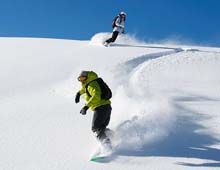Off-Piste Snowboarding Insurance
At DOGTAG Travel Insurance we understand that all skiers and snowboarders have ambitions to get off-piste whenever the conditions allow so we don’t see why it should be a separate level of cover; it should simply be included in our standard level of winter sports cover.

So, if you chose our Winter Sports Cover (of the appropriate duration) with your Annual Multi Trip, or Single Trip Insurance, you’ll automatically be covered for off piste skiing and snowboarding.
We often get asked by people looking for off-piste travel insurance what our definition of ‘Off-Piste’ is so we’ve given that below. It also appears in our FAQ’s. You should have a read at this because it’s important to understand the difference between standard off-piste travel insurance cover and other types of ‘out-of-resort’ skiing and boarding travel insurance.
Off-Piste – Standard Definitions:
The generally accepted understanding of off-piste (or backcountry) skiing or boarding means ‘going out of bounds’, i.e. outside the resort boundary (if there is a boundary) or simply off the marked pistes if within the resort area. If you are going out of bounds or outside marked areas of the resort, we recommend you do so with a fully qualified local guide because, in our view, you will be taken to the best areas and you’ll have a higher degree of comfort concerning your safety. However, we do not insist that you take a guide, you are insured for off-piste without a guide provided that you are not going alone or going against advice. And remember, even some areas within a resort may be considered out of bounds because they are hazardous. In most parts of North America, going out of bounds contravenes local law and you may, at best, have your lift pass confiscated or worse, face arrest. Normally there is a physical fence with warning signs so you shouldn’t be in any doubt.
It is your responsibility to ensure that on any particular day you are aware of and obey local advice, information and instructions given by the resort authorities and that you obey any signs and information you encounter on the mountain – the source of this information will vary resort to resort and country to country and it is your responsibility to it find out. If a section is marked ‘closed’ there will be a very good reason for it (e.g. high avalanche danger) and ignoring such signs or advice may invalidate your cover. You should be aware that under the terms of cover, needless self-exposure to peril except in an endeavour to save human life may invalidate your cover.
Obviously, you must never ski off-piste alone.
Other types of “off-piste” skiing.
There are several other types of skiing where you will venture off-piste, out of the resort or ‘out of bounds’ but for which you require a higher level of cover, say, Sport+ or Extreme. This is because these specific types of off-piste are innately more risky that venturing off-piste according to the above definition.
If, for instance you intend to venture off-piste by helicopter, most commonly known as ‘heliskiing’ or ‘heliboarding’ or its close relative, ‘Cat’-skiing and boarding or expect that you might be tempted to give it a try when you’re on holiday, then you will need a higher level of cover. Both of those types of ‘off-piste’ skiing require our Sport+ level of cover.
Similarly, Ski Mountaineering and Ski Touring are sports which can take you into the wild and untracked places of the mountains. Plainly, the risks of exposure to cold, fatigue and injury are greater here than in other commonly skied areas of the mountains. Consequently, both of these types of ‘off-piste’ activity require DOGTAG Extreme cover. If you chose the Extreme level of cover for say, Ski Mountaineering, it will automatically cover you for lower Sport+ and Sport grades of skiing too. If you want to know which category each sport falls into just check the Sports List.
As a general rule, if you are using ski mountaineering equipment and accessing areas not served by lift, gaining height by “skinning” or climbing or hiking, then you are ski mountaineering and should ensure you have the right level of cover in place.
Equipment and Safety:
Having adequate off-piste insurance is all very well but in order to get the maximum enjoyment and to minimise risk, you should take stock of a few issues: make sure your kit is in full working order, that you are fit enough to undertake the physical exertion required when skiing or snowboarding off-piste, that you have the necessary skills and that you have appropriate safety equipment. For instance, a helmet is considered de rigueur these days for all the right reasons. If you think that you might be tempted to venture into a wooded area then it is complete madness to go there without adequate head protection so… get a lid. You’ll also find that it’s easier to control your temperature with a helmet with adjustable vents than it is, say, with a wooly hat. And a woolly hat isn’t tree-proof.
Avalanche safety and all the related equipment is a book in itself. Our view is simple: the equipment is useless without the training.
Will I automatically get Helicopter Rescue?
Ski patrollers are generally very well trained and experienced at assessing injuries and managing the evacuation of the injured person off the mountain and to hospital in the manner most appropriate to the injured person’s condition. They decide what is appropriate for the circumstances regardless of who insures you. Serious cases often involve helicopters but, more often, a combination of sled and ski lift is more immediate and appropriate. Other factors such as weather are also taken into account. Again, it is not uncommon to be asked for proof of insurance whilst on the mountain.
You can find some other useful information regarding sports that we cover in our Sports Information Library.
The DOGTAG Team
p.s. if you think this information was useful, why not recommend it to a friend using one of the links below.
